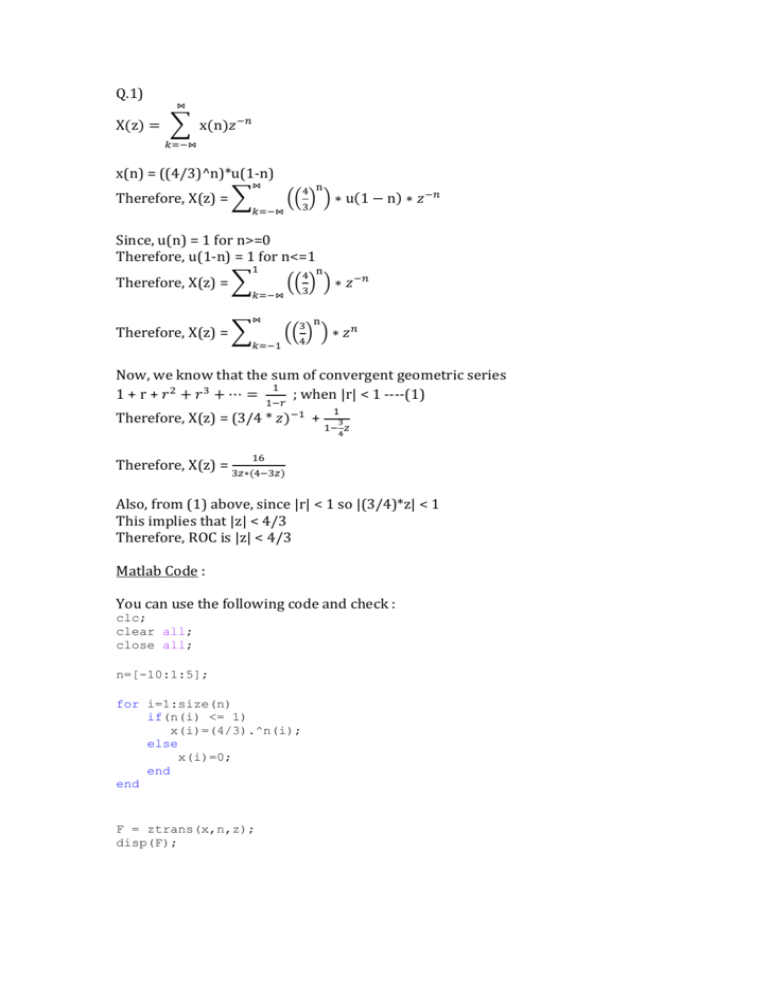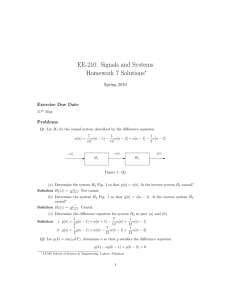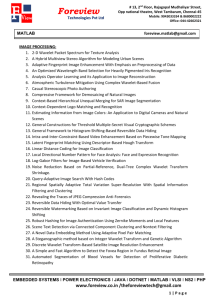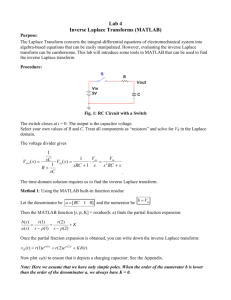Therefore, X(z) - s3.amazonaws.com
advertisement

Q.1)
⋈
X(z) = ∑ x(n)𝑧 −𝑛
𝑘=−⋈
x(n) = ((4/3)^n)*u(1-n)
Therefore, X(z) = ∑
⋈
4 n
𝑘=−⋈
((3) ) ∗ u(1 − n) ∗ 𝑧 −𝑛
Since, u(n) = 1 for n>=0
Therefore, u(1-n) = 1 for n<=1
Therefore, X(z) = ∑
1
4 n
𝑘=−⋈
Therefore, X(z) = ∑
⋈
𝑘=−1
((3) ) ∗ 𝑧 −𝑛
3 n
((4) ) ∗ 𝑧 𝑛
Now, we know that the sum of convergent geometric series
1
1 + r + 𝑟 2 + 𝑟 3 + ⋯ = 1−𝑟 ; when |r| < 1 ----(1)
Therefore, X(z) = (3/4 * 𝑧)−1 +
1
3
4
1− 𝑧
16
Therefore, X(z) = 3𝑧∗(4−3𝑧)
Also, from (1) above, since |r| < 1 so |(3/4)*z| < 1
This implies that |z| < 4/3
Therefore, ROC is |z| < 4/3
Matlab Code :
You can use the following code and check :
clc;
clear all;
close all;
n=[-10:1:5];
for i=1:size(n)
if(n(i) <= 1)
x(i)=(4/3).^n(i);
else
x(i)=0;
end
end
F = ztrans(x,n,z);
disp(F);
Q.2)
𝑝𝑖
Here, it is given that x(n) = 1/2𝑛 ∗ cos ( 4 (𝑛 − 1)) ∗ 𝑢(𝑛 − 1)Therefore X(z) =
⋈
1 ,𝑛 ≥ 1
∑𝑘=1 x(n)𝑧 −𝑛 (Since, u(n-1) = {
)
0, 𝑜𝑡ℎ𝑒𝑟𝑤𝑖𝑠𝑒
Now, by the convolution property,
If two functions x1(n) and x2(n) are multiplied in time domain, it is equivalent to
convolution of their respective z-transforms, and vice-versa.
𝑝𝑖
Here, x1(n) = 1/2𝑛 and x2(n) = cos ( 4 (𝑛 − 1))
Therefore, X1(z) =
1
2
( )∗𝑧 −1
1
2
1−( )∗𝑧 −1
and X2(z) =
𝑧∗(√2−
1
)−1
√2
𝑧 2 −√2𝑧+1
Therefore, the final answer X(z) should be convolution of X1(z) with X2(z).
Once we get required X(z), we need to find in terms of partial fractions so that
we get proper fractions. So it should look like :
𝑏0∗𝑧 −1
X(z) = r𝑧 −1 + 1+𝑎0𝑧 −1 +𝑎1𝑧 −2 + …
Thus, we from each of the fractions we find the ROC’s and finally obtain the
required ROC using set theory, i.e., ROC = ROC1⋂𝑅𝑂𝐶2⋂𝑅𝑂𝐶3 ….
The poles and zeroes are plotted by equating denominators and numerators,
respectively, to zero.
Matlab code :
Convolution can be found using command :
conv(X1,X2)
[r,p,k] = residue(b,a); this command gives partial fraction form of resulting z
transform.
In order to find pole-zero map, the following can be done :
H= tf([2 5 1],[1 2 3]); (the numbers here are just an example of the numerator
and denominator coefficients)
pzmap(H)
Q.3)
Here, it is given that x(n) = ((1/2)^n)*u(n) ⇔ 𝑋(𝑧)
We need to find x1(n) ⇔ zX(𝑧 −1)
We must first find X(z) which comes as
Therefore, X(𝑧 −1 ) =
1
1
1
1− 𝑧 −1
2
1
1− 𝑧
2
𝑧
Therefore, z X(𝑧 −1 ) =
1
2
1− 𝑧
Now it’s inverse z transform can be found by reducing it to partial fraction.
Matlab :
In matlab, by giving iztrans(
𝑧
1
2
1− 𝑧
), the inverse z transform can be found.
Q.4)
This problem is quite easy. Just expand the function X(z) first.
Matlab Code :
Using iztrans command the inverse z transform can be found and using pzmap,
pole-zero map can be plotted.
Q.6)
First, reduce the given function to partial fraction form.
Next, find the inverse z transforms of each of these partial fractions. This gives
the inverse z transform of the function (by linearity property).
We can plot this x(n) against ‘n’ using the plot(n,x) command specifying the
points of ‘n’.
![2E2 Tutorial sheet 7 Solution [Wednesday December 6th, 2000] 1. Find the](http://s2.studylib.net/store/data/010571898_1-99507f56677e58ec88d5d0d1cbccccbc-300x300.png)










